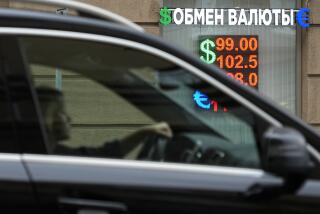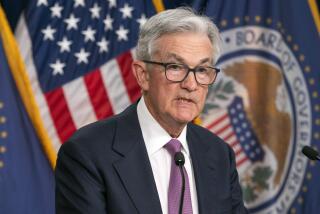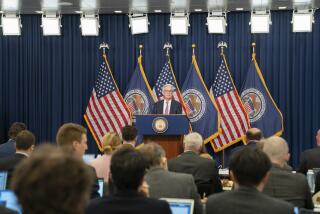Bank of England Hikes Key Interest Rate in Struggle to Curb Inflation
- Share via
LONDON — Currency speculators abandoned the British pound for the dollar Thursday, making it possible for Prime Minister Margaret Thatcher’s government to raise interest rates and renew its struggle to curb inflation.
The Bank of England hiked its key money market lending rate half a point, signaling commercial banks to lift their base lending rates from 10-year lows of 7.5% to 8%.
The move appeared to conclude a long politically tinged drama over the pound’s value in the world markets. In the past two months, the pound climbed out of its range below 3 West German marks, reflecting the strength of the British economy and the relatively high interest rates.
Finance Minister Nigel Lawson worried that the currency’s rise as high as 3.20 marks and $1.90 would crimp British export earnings and swell the nation’s already high balance-of-payments deficit. It also would run contrary to the Group of Seven industrial nations’ aim of stabilizing world currencies.
The easiest way to reduce demand for a particular currency is to lower interest rates as the banks did May 17, but Thatcher was concerned that a credit-fueled consumer boom was already threatening to rekindle inflation--currently running at a 3.9% rate. She recoiled from the idea of reducing interest rates further.
Lawson’s most recent cut in interest rates was widely considered to be economically risky, given the evident signs of a credit boom and an overheating economy. It was mainly designed to discourage overseas money flooding into sterling.
The central bank’s decision Thursday to nudge rates higher, political sources said, was made only after Lawson and Thatcher held late night talks to resolve their highly publicized policy dispute.
The move also reflected the diminished appeal in the past week or so of the pound, whose strength is already stinging exporters, according the Confederation of British Industry.
The dollar is now attracting money, on speculation that U.S. interest rates may be headed higher.
Strong West German trade figures have also made the mark look like a good bet.
Currency dealers said a selloff in the pound Thursday morning knocked the British currency to a three-month low against the dollar of $1.7940 and to below 3.11 marks. It closed in London at $1.8005 and 3.1020 marks.
“Sterling is going through support points like a knife through butter,” said Tim Fox, an economist with Barclays Bank PLC. Since its mid-May highs, the pound is down almost 3% against the mark and about 5% against the dollar.
There were conflicting reports in the markets as to whether the central banks had intervened to slow the dollar’s advance.
Some reports said the Bank of England, along with the Bundesbank and the Federal Reserve, sold dollars for marks and pounds.
“It would make sense for the Bank of England to intervene, but we haven’t seen anything ourselves,” said a foreign exchange dealer at a major U.S. bank that frequently does business with the New York Federal Reserve Bank when it intervenes for the U.S. Treasury in the markets.
The pound’s decline cleared the way for the Bank of England to tighten rates and for the Treasury to say this measure was taken to “keep monetary policy firm.”
Barclays Bank PLC and Midland Bank nudged their lending rates half a point to 8% soon afterward.
Meanwhile, a sharp rise in the trend-setting Bank of Canada interest rate Thursday impelled the nation’s six largest chartered banks to raise their prime lending rates.
Increases in the prime were announced just minutes after the inflation-conscious central bank moved its key rate to 9.49% from 9.17%.
Royal Bank of Canada, Bank of Montreal, Toronto-Dominion Bank, Canadian Imperial Bank of Commerce, Bank of Nova Scotia and National Bank of Canada said they would raise their prime rates to 10.75% from 10.25% today.
The increase by the central bank, worried that wage pressures and a strong economy will fuel inflation, was even larger than many analysts expected.
The banks said they were forced to raise their rates because it costs them more to borrow funds.
More to Read
Sign up for Essential California
The most important California stories and recommendations in your inbox every morning.
You may occasionally receive promotional content from the Los Angeles Times.













